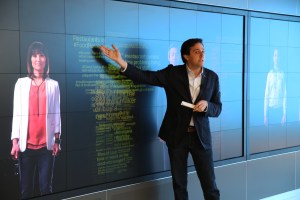Armed with $1 billion in financing, an unprecedented degree of autonomy within IBM, and an entire Manhattan city block, IBM launched its media blitz to show the world its vision of a future enhanced and enabled by Watson, its artificial intelligence technology.

So today 28 reporters convened on the fifth floor of 51 Astor Place with the IBM Sherlocks who would manage Watson in order to get a taste of the “Watson Experience.” Amid a heady mix of high-tech, flat-paneled display wizardry and more than a little razzle-dazzle of Hollywood showmanship, executives from the Watson program laid out, more specifically, their vision for the future of artificial intelligence’s big brother.
Beyond platitudes like the director of symbiotic cognitive systems for the IBM Watson Group, Dario Gil, telling a crowd that, “People are at the center of the Watson experience,” what’s truly at the heart of the Watson experience are the startups and companies that are going to use Watson. At least that’s what John Gordon, a vice president with IBM Watson told us in a video interview from the day.
And as for companies that are working with Watson, there are already a slew of them.
Ole Big Blue pulled out the stops for the show at its new headquarters just south of Union Square, touting the ways in which hospitals from Thailand, health care groups from South Africa, Australian universities, and Spanish banks were using Watson to transform their various disciplines, curriculum and industries.
In all IBM revealed that it was working with companies across six continents and in over 25 countries through its new Watson initiatives. The distributed intelligence is learning Spanish through its work with Caixa Bank in Spain, and helping financial managers in Australia to offer improved advice for their customers.
At Thailand’s Bumrungrad International Hospital, Watson is being used to improve cancer treatments through a program developed jointly with New York’s Memorial Sloan Kettering, which will also be deployed at referral offices in 16 countries that feed into the Bangkok hospital.
In Australia’s Deakin University, Watson will provide online student advisory services for the school’s 50,000 students, answering questions ranging from directions, to queries about social activities and course requirements. And wrapping up Watson’s big enterprise international tour, the Metropolitan Health Group in South Africa is using Watson to provide customer health advisory services for the company’s nearly 3 million customers. 
Beyond medical facilities and universities, a bevy of new startups are building entire businesses on Watson’s artificial intelligence. Travelocity founder Terry Jones, who was also the founding chairman of Kayak.com launched his new company WayBlazer on the back of Watson.
The London-based startup Red Ant is using Watson as a customer relationship management tool over a mobile app; Dedham, Mass.-based Reflexis has Watson providing real-time alerts to store managers, while Emeryville, Calif.-based Sellpoints has taken Watson’s near infinite understanding of data and turned it into a way to link consumer questions with products on a company’s site.
New companies like Findability Sciences (also based in Waltham) are using Watson to link funders and donors with non-profits, leveraging Watson’s brainpower for the greater good. The list goes on… and on… and on… with SparkCognition using Watson in its Austin-based company to act like a security expert and try to suss out new security threats before they’re developed. Pleasanton, Calif.-based GenieMD is using Watson to power its recommendations to patients that call in to its mobile platform for answers to healthcare questions.
Closer to the ancestral seat of IBM’s power, in Syosset, NY, CHIPS Technology Group collates white papers, articles and manuals to provide tech support responses, all through Watson’s observation, understanding, evaluation, and relevance decision engines.
IBM has staked a lot on Watson, and this distributed model of selling artificial intelligence to the masses, but the company’s employees are true believers in the transformative power of Watson to change the ways human interact with computers.
For the company it’s a step-change in the evolution of technology in the same way that the machine age brought a new relationship between humanity and its tools.
“Working with cognitive computing is a dialogue,” said Gil in his presentation on Watson’s ability to heal the sick. “[It has] the capacity to enhance and scale our minds in a partnership.”